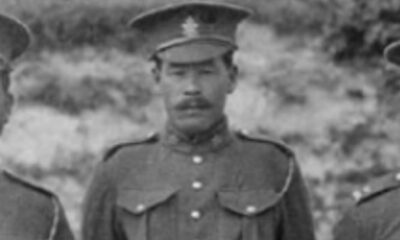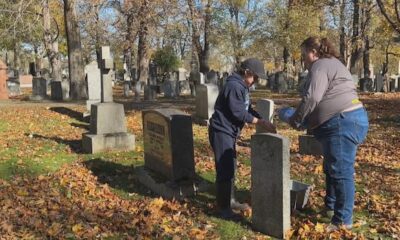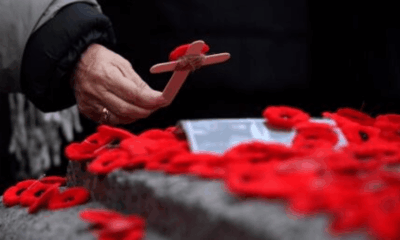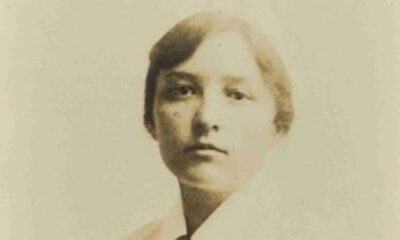Top Stories
Volunteers Race to Preserve Canadian Soldiers’ WWII Carvings
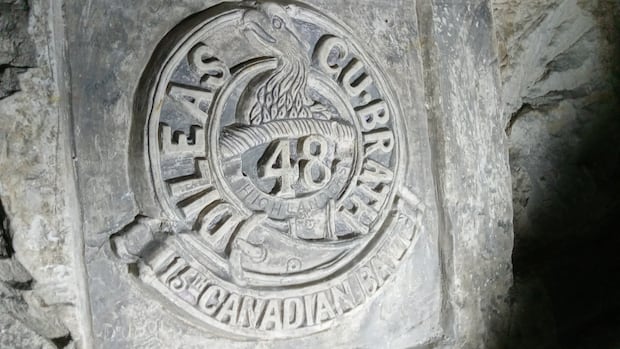
UPDATE: Volunteers are urgently working to preserve historic carvings left by Canadian soldiers during the First World War at the Maison Blanche souterrain in northern France. This critical preservation effort is taking place as the site faces deterioration risks.
Just recently, a dedicated team from Canadigm and the U.K.-based Durand Group revisited the quarry to document the poignant markings left by soldiers more than a century ago. These volunteers are racing against time to preserve a crucial piece of Canadian heritage before the cave’s structural integrity is compromised.
The Maison Blanche souterrain, located near the historic Vimy Ridge, served as a shelter for hundreds of Canadian troops in late 1916, just before the pivotal Battle of Vimy Ridge, which began on April 9, 1917. While exploring the site, volunteers uncovered intricate carvings that reveal the soldiers’ thoughts and emotions during wartime.
David Hedges, a volunteer with the Durand Group, described the cave as “the richest cave that’s ever been found” on the Western Front. “More than 750 soldiers left their names on the walls,” he stated, emphasizing the site’s significance for historical documentation.
Among the carvings are heartfelt tributes, including a mailbox where soldiers could leave letters to loved ones, which would only be sent if they survived their next battle. This poignant reminder of their vulnerability resonates deeply with visitors.
Zenon Andrusyszyn, artistic and executive director of Canadigm, noted the emotional weight of these discoveries. “It’s a humbling experience to go down there, knowing that we were travelling in the footsteps of the Canadian soldiers,” he shared in a recent interview.
The preservation project is not without challenges. The quarry, once a dumping ground, was forgotten until its rediscovery in 2006. Recent excavations revealed that some sections of the cave remain hidden beneath debris, with new carvings still being uncovered. One recent find included a carving that read “April 9 Grand Advance,” a direct reference to the upcoming battle.
Hedges highlighted the urgent need for documentation, stating, “There is no guarantee that this cave is going to last another 100 years.” The team is employing advanced 3D scanning technology to meticulously capture the carvings, ensuring their history is preserved for future generations.
The emotional stories behind the carvings also shed light on the soldiers’ lives. For instance, Earl Laroy Lacey carved images of farm animals, reflecting his longing for home, while others, like Norman Allatt, sketched portraits of loved ones. Tragically, many of these soldiers, including Lacey, did not survive the war.
As the preservation team continues its work, they are also organizing visits for families of the soldiers. Hedges expressed the importance of these visits: “It is a great experience to bring families back and stand where their own relative was in the First World War.”
The team is aware of the looming threat posed by time and environmental factors. In some areas, the distance between the cave and the surface is alarmingly thin. Hedges warned, “Eventually it will collapse, as is the fate of all souterraines.”
This urgent endeavor not only seeks to safeguard a vital piece of history but also to create a deeper connection between Canadians today and their ancestors who fought for their country. Andrusyszyn envisions a future where the names and stories of these soldiers are accessible to everyone through a dedicated website, ensuring their legacies endure.
With time running out, the dedicated volunteers remain committed to their mission. This ongoing effort serves as a reminder of the sacrifices made by Canadian soldiers, and the importance of preserving their stories for future generations.
Stay tuned for more updates as this preservation project continues to unfold.
-

 World4 months ago
World4 months agoScientists Unearth Ancient Antarctic Ice to Unlock Climate Secrets
-

 Politics4 days ago
Politics4 days agoSecwepemc First Nation Seeks Aboriginal Title Over Kamloops Area
-

 Entertainment4 months ago
Entertainment4 months agoTrump and McCormick to Announce $70 Billion Energy Investments
-

 Lifestyle4 months ago
Lifestyle4 months agoTransLink Launches Food Truck Program to Boost Revenue in Vancouver
-

 Science4 months ago
Science4 months agoFour Astronauts Return to Earth After International Space Station Mission
-

 Technology2 months ago
Technology2 months agoApple Notes Enhances Functionality with Markdown Support in macOS 26
-

 Top Stories4 weeks ago
Top Stories4 weeks agoUrgent Update: Fatal Crash on Highway 99 Claims Life of Pitt Meadows Man
-

 Sports4 months ago
Sports4 months agoSearch Underway for Missing Hunter Amid Hokkaido Bear Emergency
-

 Politics3 months ago
Politics3 months agoUkrainian Tennis Star Elina Svitolina Faces Death Threats Online
-

 Politics4 months ago
Politics4 months agoCarney Engages First Nations Leaders at Development Law Summit
-

 Technology4 months ago
Technology4 months agoFrosthaven Launches Early Access on July 31, 2025
-

 Top Stories2 weeks ago
Top Stories2 weeks agoFamily Remembers Beverley Rowbotham 25 Years After Murder

